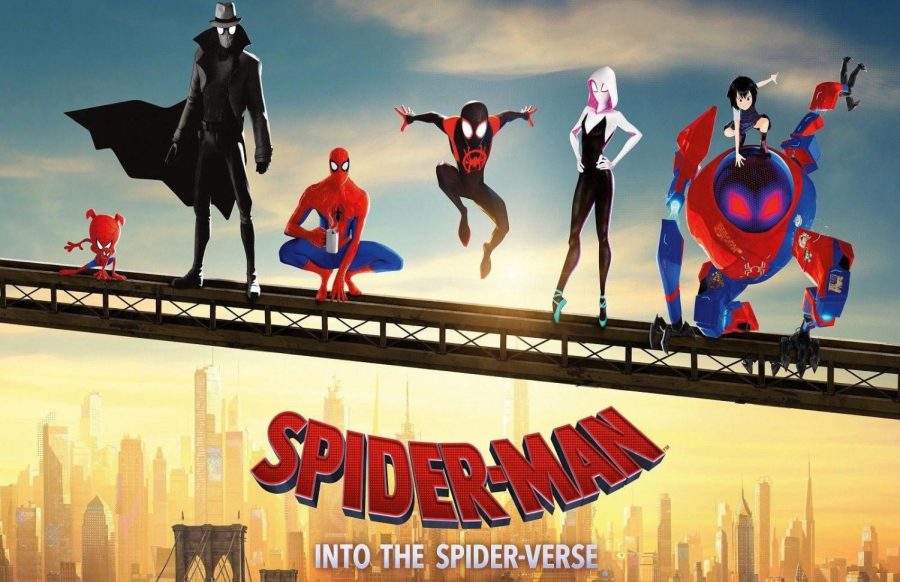Into the Spiderverse: A New Type of Superhero
January 30, 2019
I’m about to tell you about my current favorite movie. It’s a little number going by the name of Into the Spider-Verse, and I lied when I said it was little, it’s actually around 2 hours long. Although I’m usually hesitant to commit to something I can’t turn off after 20 minutes of laugh-tracking and easy humor, your girl sat through this movie not once, but TWICE. And I’m still planning on going again.
When you look for a movie to watch, what do you want? Plot, character development, consistency? Art style, good representation? A fire soundtrack? Well, good news for you if you answered any or all of the above; Spider-Verse has you covered.
The plot is easy to follow and does a good job of not making a mess of itself (which, admittedly, tends to happen quite a bit in superhero stories). It starts out as a day in the life of Miles Morales, a new student at a stiff (and uppity) charter school in New York City. With a student body whose personality is as colorful as its uniforms (that is to say, not very), Miles—with his stylistically untied shoes and cringy jokes—doesn’t fit in. And he doesn’t really want to. He escapes the dreary prep-school world to paint with his Uncle Aaron, the only person who really seems to understand him. His strong friendship with his uncle causes tension between Miles and his dad, who is estranged from his brother (these relationships are set up to give some beautiful character development later in the film). Uncle Aaron encourages behavior Miles’ dad is against—specifically street art. To cheer Miles up, Uncle Aaron takes him into the subway tunnels to paint Miles’ newest design. It is down here that the story we will know so well starts: an Oz-enhanced spider sidles up to Miles and chomps on his hand. The change is not immediate, but Miles sleeps for two days and wakes up a foot taller and the ability to stick to things when panicked.
I would go on, but everything that happens next is kind of a spoiler. So instead let’s talk about the rad character development in this movie! We all knew it was a superhero film, but what people don’t know is that it doubles as a bildungsroman—a coming-of-age story for the one-and-only Spider-Man (that’s a joke, watch the movie). Miles Morales is, as previously mentioned, not at home in his new school environment. He is a jokester, he wants to make people smile, and the students at his charter school…don’t. Smile, or joke, or seemingly have fun, that is. As a result, the Miles that starts the movie isn’t super happy—he’s out of place, he’s overworked, he’s underconfident. And he’s angry. He’s trying so hard to be the best in everyone’s eyes, but he’s also trying to find the best way to be true to himself. He doesn’t want to assimilate with his monotone classmates, but they make it hard to stand out. He wants to go back to his old school, but he doesn’t want to disappoint his dad. Miles, who is just a teenager, is struggling to fulfill all these great expectations. When he becomes Spider-Man, suddenly his confidence crisis becomes much more consequential—“no expectations” becomes “the only one who can save the multi-verse.” This movie follows Miles who, over a short period of time, gains six great new friends, strengthens his incredible familial bond, and cultivates a genuine and unshakeable confidence. At its core, this movie is about growing up, and how having “no expectations” can allow you to fulfill the greatest of them all.
FINALLY—I get to rant about the soundtrack. I said this sentence out loud and my boyfriend replied, “Are you ranting, or are you falling in love with it?” He’s right. The soundtrack is great. But what is even greater is the way the soundtrack is integrated into the movie. Beyond being a background track, meant to subtly direct your emotions, the music interacts with the characters on-screen. Post-Malone’s “Sunflower” comes through Miles’ headphones as he bops along (singing terribly) before school. When he rushes around the house (having forgotten to pack) the music doesn’t stop but it does change—the music is fainter, and lower quality, because his headphones are now around his neck instead of over his ears. This is consistent throughout the movie and I really enjoyed it because it creates a unique situation for the viewer. By manipulating the soundtrack in this way—through headphones, radio stations, etc.—the movie connects our experience with the experiences of the characters. If you’re hearing a bop, they’re hearing it too.
All in all, I hope my positive ravings convince you to give Into the Spider-Verse a go. Or, if you’ve already seen it, how about we try this one more time!











